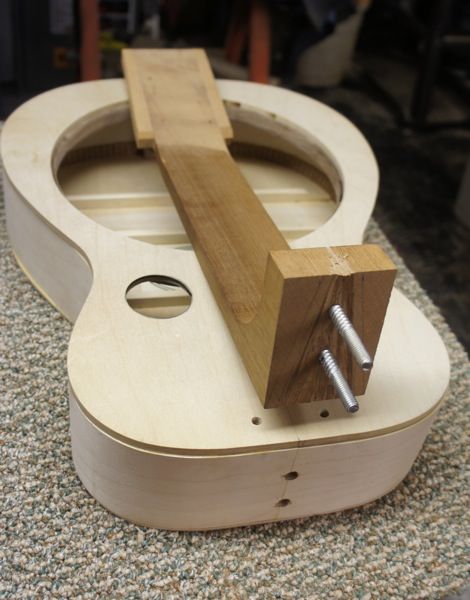OK, here are some measurements taken from my two factory built resonators. The are quick measurements so they might vary by +/- 1/16

1932 Dobro type 27. This was their cheapest model (sold for $27 new) - birch plywood body, spider cone, round neck, 12 frets clear, slot head. Upper bout - 10-5/8, lower bout 14-1/8, waist - 9, body length - 19-5/8, depth at heel - 3-3/8, scale - 24.5, nut 1-3/4+, string spacing at saddle 2-1/4, fretboard radius - flat. Didn't measure the cone well rim depth.
1980 Dobro Duolian. Bell brass body, biscuit cone, round neck, 14 frets clear, paddle head. This is very similar to a
14 fret National type 0. UB - 10-1/4, LB - 14-1/8, waist - 9-3/4, length - 18-1/4 (this is a 14 fretter, remember), depth - 3-3/8, scale - 24.5, nut 1-11/16, saddle spacing 2-1/16, fretboard radius - 16. Cone well rim depth is 1 inch as is my tricone.
If anyone is interested I can also post the specs of my tricone build - it is roughly an OM size body but fairly deep (4 inches) and only 12 frets clear.
I am sure that the OP knows what type of resonator he wants to build and how he will play it, but let me add some random thoughts.
- You can play a round neck lap style but it will slide around. You cannot play a square neck Spanish style. Hawaiian music was played on square neck tricones - I've never seen a square neck biscuit.
If you are in doubt, build a roundie - you can alway add a nut extender to play lap.
- If you want a true bluegrass dobro you want spider bridge, square neck, wide flat fretboard, action about 3/8 from end to end. Since you will string it heavy (16-56) and tune the bottom 2 strings up, I would build a neck stick. Do not glue the fretboard extension down (put two flat head screws under two of the dots) - you will need to change the neck angle to set action. The break point of the saddle will be exactly 2X the distance to 12. You can use a traditional cone well like my photos or a short well with some support sticks - resonator forums have lots of discussion about internal construction. Slot heads have the advantage that you can turn the tuners to face up - much easier to tune the guitar while it sits on your lap.
- If you plan to play Spanish style fretted, slide or a combination you want a round neck, either spider or biscuit or tricone depending on sound. If you will be 90 percent fretted consider a narrower radiused fretboard like my Duolian, however if you will be mostly slide I think a good compromise is 1-3/4 at the nut, 2-1/4 at the saddle and maybe 20-24 inch radius. Set the action just a hair higher than you would a normal acoustic but don't get carried away - maybe 0.080 on the high string and 0.090 or a little more on the low. I cut the nut slots close to the zero fret line. If your strings are basically flat you don't need super high action and it will be easier to fret.
- most resos have no compensation - the saddle is at 2X the distance to 12 and is straight across. This works OK for slide but will play pretty sharp when fretted - particularly up the neck. If you are going to play strictly fretted add some compensation.
- I used a bolt on neck on the tricone with a screwed down f/b extension. You don't have very much leeway in setup so you may have to move the neck. Neck sticks are traditional and recommended for high string tension guitars.
- when laying out your body start with the center of the cone and the location of the 12th fret - unlike an acoustic you don't get to move the bridge around at the end of the build. Also calculate the neck angle, cone height, cover plate and hand rest carefully. If its wood body, allow enough meet around the cone well for the screws.
- buy the best cones you can - thats what makes the sound. National "hot rods" for a biscuit or tricone, Quarterman or Beards for a spider. I've got a Paul Norman carbon fiber biscuit in mine - probably a waste of money over a good maple one. Ebony topped saddles in both the spider and tricone.
- build a "standard" size guitar that will fit a normal case. Most resonator cases have an indentation for the coverplate and palm rest as well as the tailpiece. A square neck needs a square neck case. Because my tricone is an odd ball I had to have a special case built which was not cheap.

Lastly, here is a build thread for the koa tricone. Not saying this is the best way to do it but it worked for me (fwiw, I called out the action at 0.090 high and 0.100 low, but I lowered it a bit after that)
http://bigroadblues.com/forum/viewtopic.php?f=3&t=11037






